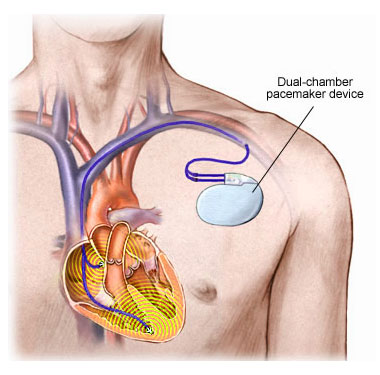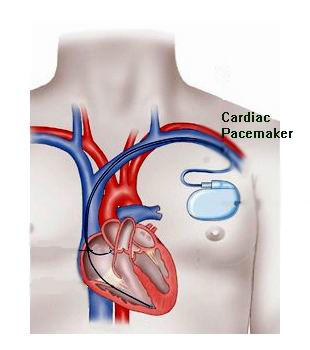
A pacemaker is a small medical device implanted in the chest to help regulate the heart's rhythm. It is used to treat various types of arrhythmias (abnormal heart rhythms), particularly those that cause the heart to beat too slowly (bradycardia). The pacemaker sends electrical impulses to the heart to maintain a normal heartbeat, ensuring that blood is pumped efficiently throughout the body. Pacemaker implantation is typically performed when the heart's natural pacemaker (the sinoatrial node) is unable to regulate the heart rate effectively, resulting in symptoms such as dizziness, fatigue, or fainting. This procedure is often minimally invasive and is done under local anesthesia, with most patients able to return home the same day or after a short hospital stay.
A pacemaker may be required when there are issues with the heart’s electrical system that lead to abnormal heart rhythms. The following are common causes and risk factors that may necessitate pacemaker implantation:

Causes of Arrhythmias Leading to Pacemaker Use:
-
Bradycardia: A condition where the heart beats too slowly, usually under 60 beats per minute, which can lead to symptoms like fatigue, dizziness, or fainting.
-
Heart block: A type of arrhythmia where electrical signals in the heart are delayed or blocked, preventing the heart from beating at a normal rate.
-
Sick sinus syndrome: A condition in which the sinus node, the heart's natural pacemaker, doesn’t work properly, leading to irregular heart rhythms.
-
Atrial fibrillation or other tachycardias: In some cases, when medications to control heart rate are ineffective, a pacemaker can be implanted to regulate the rhythm.
Risk Factors for Arrhythmias:
-
Age: Older adults are more likely to experience arrhythmias and may need a pacemaker to manage heart function.
-
Heart disease: Conditions like coronary artery disease, heart attack, and heart failure can damage the heart’s electrical system and require pacemaker implantation.
-
High blood pressure: Hypertension can strain the heart, potentially leading to arrhythmias.
-
Genetics: In some cases, arrhythmias can run in families and may require pacemaker implantation.
-
Previous heart surgery: Heart surgeries, especially valve replacements or bypass surgery, can damage the heart’s electrical pathways, leading to arrhythmias.
The symptoms of arrhythmias can range from mild to severe, and a pacemaker is typically considered when symptoms become debilitating or pose a risk to a patient's health. The most common symptoms that indicate the need for a pacemaker include: Common Symptoms of Arrhythmias:
Diagnosing arrhythmias and determining the need for a pacemaker typically involves a combination of physical examinations, tests, and imaging studies. These tests help identify the type of arrhythmia, its severity, and whether a pacemaker is the most appropriate treatment.
Diagnostic Tests Include:
-
Electrocardiogram (ECG): A primary test used to detect abnormal heart rhythms by measuring the electrical activity of the heart.
-
Holter monitor: A portable device worn for 24–48 hours that continuously records the heart’s electrical activity to identify intermittent arrhythmias.
-
Echocardiogram: A non-invasive ultrasound test that evaluates the structure and function of the heart, helping to identify underlying heart disease or conditions contributing to arrhythmias.
-
Stress test: A test that monitors the heart's electrical activity during physical exercise, which can help detect arrhythmias that occur with exertion.
-
Electrophysiological study: A procedure where catheters are inserted into the heart to map its electrical signals, allowing doctors to identify areas of the heart that may need to be treated with a pacemaker.
Pacemaker implantation is generally a straightforward and minimally invasive procedure that is performed under local anesthesia. In most cases, the procedure takes about 1–2 hours and is performed in a hospital or specialized cardiac center.
Steps Involved in Pacemaker Implantation:
-
Preparation: The patient is positioned comfortably on an operating table. Local anesthesia is administered to numb the area where the pacemaker will be inserted, typically below the collarbone on the left side of the chest.
-
Incision: A small incision is made near the collarbone, and a small pocket is created under the skin to house the pacemaker.
-
Insertion of leads: Thin, flexible wires (leads) are inserted into the heart through a vein and guided to the heart’s chambers. These leads are responsible for sending electrical impulses to regulate the heart's rhythm.
-
Pacemaker implantation: The pacemaker device itself is then connected to the leads and placed under the skin, just below the collarbone. The device is typically about the size of a matchbox and is programmed to deliver electrical impulses to the heart as needed.
-
Testing and adjustment: Once the pacemaker is implanted, the doctor tests the leads and device to ensure that it is working properly. The device is programmed to regulate the heart’s rhythm according to the patient’s needs.
-
Closure and recovery: The incision is closed with stitches, and the patient is monitored in a recovery room. Most patients can go home the same day or the day after the procedure, depending on their condition.
While pacemaker implantation is generally safe, like any surgical procedure, it carries some risks and potential complications. The risks associated with pacemaker implantation include:
Possible Complications:
-
Infection: There is a risk of infection at the incision site or around the pacemaker leads.
-
Bleeding or hematoma: Minor bleeding or bruising at the implantation site may occur.
-
Lead displacement: The leads may become dislodged, requiring repositioning or another procedure.
-
Pneumothorax: In rare cases, the lung may be punctured during the insertion of leads, leading to a collapsed lung.
-
Arrhythmias: In some cases, the pacemaker may cause abnormal heart rhythms, though this is rare and can usually be adjusted.
-
Device malfunction: Although rare, the pacemaker may not function as expected, requiring replacement or reprogramming.
Before the procedure, the doctor will discuss the potential risks and benefits with the patient and answer any questions to ensure informed consent.
After pacemaker implantation, most patients can resume normal activities within a few days, but they should avoid heavy lifting and strenuous exercise for a few weeks to allow the incision site to heal properly.
Recovery Tips:
-
Follow-up appointments: The patient will need to attend follow-up appointments to monitor the pacemaker’s function and ensure the device is working properly.
-
Avoid certain activities: In the first few weeks after surgery, it is important to avoid activities that could strain the chest area, such as heavy lifting or certain arm movements.
-
Wound care: The incision site should be kept clean and dry to prevent infection.
-
Heart monitoring: The pacemaker is typically monitored remotely by the healthcare provider to ensure that it is working correctly.
A pacemaker can significantly improve the quality of life for individuals with arrhythmias. Many patients report a dramatic reduction in symptoms such as dizziness, fatigue, and fainting after the procedure. However, living with a pacemaker involves regular check-ups, monitoring, and lifestyle adjustments.
Lifestyle Considerations:
-
Exercise: Most patients can return to regular physical activity after recovery, but they may need to avoid contact sports or activities that could impact the pacemaker.
-
Medical alerts: It is recommended to carry a medical ID card that indicates you have a pacemaker, especially in case of an emergency.
-
Avoid strong magnetic fields: Certain devices and equipment, such as MRI machines or large magnets, may interfere with pacemaker function.
-
Traveling: Pacemaker patients can travel, but they should inform airport security about the device, as it may trigger metal detectors.
With the right precautions and care, individuals with pacemakers can enjoy a full and active life.
The other major cardiac procedures are:
Few popular hospitals for Pacemaker Implantation are:
Thailand, Malaysia, Singapore, Turkey and India are the most cost effective locations that offer up to almost 80% savings in comparison to the US.
SurgeryPlanet facilitates a plethora of services to the medical treatment traveler also which includes, a hassle free and discounted travel option, a welcome hand at the airport on arrival, travel in an air-conditioned car, round the clock service & support. Your medical evaluation is pre arranged with the least of waiting time. Once your assessment is complete and found medically fit, the procedure is immediately scheduled without a waiting period. Please read through our Services and Testimonials to understand and select your best options.
Heart Rate | Fatigue | Shortness Of Breath | Fainting | Minimal Invasive Surgery | Collar Bone | Fluoroscopy | Non Invasive | Heart Rhythm | Pacemaker Checks | Pacemaker | Pacemaker Implantation | Hospitals Pacemaker Implantation | Doctors Pacemaker Implantation | Surgery Pacemaker Implantation | Cost Pacemaker Implantation | Treatment Pacemaker Implantation | Destinations Pacemaker Implantation | Pacemaker Implantation India | Pacemaker Implantation Recovery | Pacemaker Implantation Information | Pacemaker Implantation Thailand | Pacemaker Implantation Malaysia | Pacemaker Implantation Abroad | Pacemaker Implantation Overseas | Pacemaker Implantation Low Cost
SurgeryPlanet is an Healthcare Facilitator and not a Medical service provider. The information provided in this website is not to be used for diagnosis or treatment of any medical condition or use for any medical purposes. We provide information solely for medical travel facilitation and do not endorse any particular health care provider, hospital, facility, destination or any healthcare service or treatment listed. We are not an agent for, or affiliated to any health care provider, or service listed in our website and is not responsible for health care services provided by them. Choice of hospital or doctor for your healthcare services is your independent decision. Consult your domestic licensed health care provider before seeking the services of any health care provider you learn about from our website.


